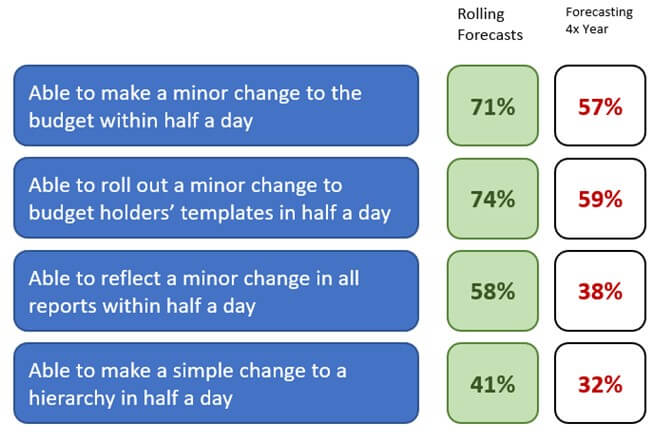This article first appeared on OneStream Software blog page by Whitney Gillespie
Most Financial Planning & Analysis (FP&A) professionals have firsthand experience with the crushing blow that comes when a just-finished financial forecast is already or soon to be outdated. Today, the business environment changes so quickly that that experience can feel disheartening to put so much time and effort into a forecast that can’t stand the test of time. But it doesn’t have to be that way – a rolling forecast can alleviate some of the pains of traditional, static forecasting methods. By implementing a more dynamic forecasting process, Finance organizations can remain competitive and stay ahead of change and uncertainty.
Future-Proof Financial Forecasts with Rolling Forecasting
A rolling forecast enables organizations to remain flexible and prepared for what’s to come with a process that favors continuous management over a fixed, static forecast that quickly becomes obsolete. A rolling forecast is a management tool used by organizations to plan continuously over a set time horizon. Why does preparing a rolling forecast matter? Well, as Finance leaders and business partners understand, keeping a pulse on all aspects of the organization is vital. That pulse-check includes both financial and operational performance. Finance must also lead the charge to implement agile budgeting, planning and forecasting processes that enable collaboration and effective decision-making between Finance, Sales, Operations, HR and other functions. Rolling forecasts are an essential tool for achieving those aims.
What kind of organizations can benefit from a rolling forecast process? Perhaps the better question is, who can’t? Interacting regularly with consumers, suppliers or regional operations simply leaves organizations with no escape. Escape from what? From the roller coaster ride and volatility of global markets today. And to make matters worse, this roller coaster ride feels like the “new norm” of what to expect.
According to the 2021 FSN Agility in Planning, Budgeting and Forecasting Global Survey, organizations that prepare rolling forecasts outperform peers that forecast 4 times a year (Figure 1).

Manage the Business with Agility Using Rolling Forecasts
Rolling forecasts allow for better agility in the face of changing business dynamics. How? They provide a blueprint for the continuous reassessment of financial results and key business drivers, as compared to the traditional yearly forecasting methods. Setting a framework for this ongoing process develops the habit and encourages inter-departmental collaboration across the organization to monitor performance on an ongoing basis. Here are three benefits of rolling forecasting:
- Increased agility: Rolling forecasting allows for more timely detection and response to changes to the financial forecast. Since the speed of business increases exponentially, having a process that supports the analysis of financial indicators with a prompt response time improves organizational agility and efficiency.
- Better risk and opportunity management: Continuous management of the financials allows organizations to better detect and respond to potential risks and opportunities. With faster indicators and response time, the business can mitigate risks, capitalize on opportunities and create a what-if analysis that runs multiple scenarios to model action.
- Improved accuracy: According to the 2021 FSN Agility in Planning, Budgeting and Forecasting Global Survey, 42% of organizations that use rolling forecasts can forecast revenue within +/- 5%, compared to 38% of peers not utilizing rolling forecasts. Regarding earnings, the organizations leveraging rolling forecasts can forecast earnings within that range 49% of the time, compared to 35% of the organizations not using rolling forecasts. Using a rolling forecast results in measured improvements in forecast accuracy versus an organization only forecasting 4x a year.
Ultimately, rolling forecasts provide a multitude of business benefits and establish Finance as an organization that can deliver timely, accurate business results. By doing so, Finance positions itself as a strategic business partner that helps steer the business toward positive financial goals and results.
Technical Enablers for Robust Rolling Forecasts
When looking to create a robust rolling forecast with a sustainable, repeatable process, organizations must seek out a unified platform that enables this vision with built-in financial data quality, workflow capabilities and self-service reporting and analytics. As a unified, Intelligent Finance platform, OneStream is designed to help increase the agility and effectiveness of not only planning, budgeting and forecasting, but also the financial close, consolidation and reporting processes. OneStream even dynamically updates reports and report books using the most current forecast. This functionality drastically cuts down the time and energy that FP&A teams spend generating reports, making it much easier to forecast monthly.
Here’s a deeper look at the benefits OneStream brings in those three areas:
- Financial Data Quality: Enable high-quality and accurate reporting that empowers Finance teams and their business partners to develop insights and guide key decisions that drive performance.
- Workflow Capabilities: Ensure no parts of the review and approval process are missed in the preparation of the rolling forecast by keeping everyone in the loop to ensure nothing gets overlooked in the planning cycle.
- Reporting and Analytics: Leverage spreadsheets as intended – as flexible, on-the-fly tools for ad-hoc analysis – to not only drive the flexibility that spreadsheets allow for data analysis but also gain control of the connection back to the source data in CPM software.
Conclusion
Rolling forecasts are a powerful tool for the timely, accurate management of financial forecasts. Gone are the days of obsolete and, frankly, unhelpful financial forecasts that take too much time and effort to prepare and become outdated the moment they’re completed. By switching to rolling forecasts, organizations can improve accuracy, efficiency and agility in their financial processes and functions, ultimately better managing the business and positioning Finance as a valued strategic business partner to stakeholders.
Learn More
To learn more about rolling forecasts and how they enable an organization to make better financial decisions, check out our Rolling Forecasts eBook here.



